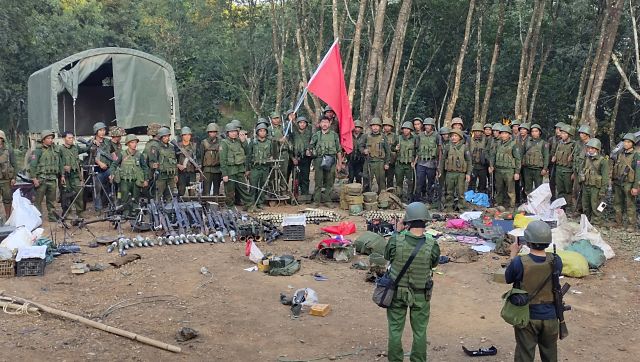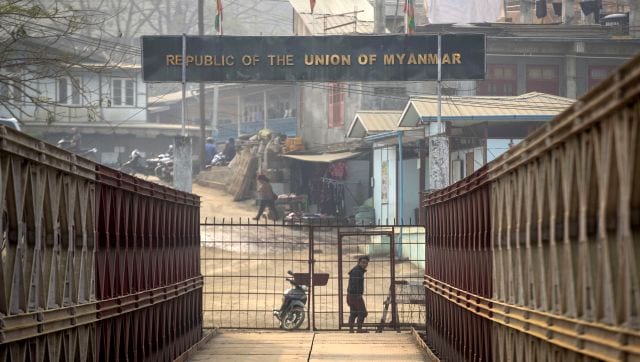“We are deeply concerned with incidents close to our border. Our position on the ongoing situation in Myanmar is very clear – we want cessation of the violence and resolution of the situation through constructive dialogue.” The Ministry of External Affairs on Thursday issued this statement in reaction to the ongoing violence in Myanmar between the military and anti-junta forces. But why is Myanmar’s internal strife a cause of concern for India? Moreover, what exactly is going in Myanmar? We take a closer look at the situation unfolding in India’s neighbouring country; India shares a 1,640-kilometre border with a number of northeastern states, including Nagaland and Manipur, and the impact of Myanmar’s violence being felt in India. ‘Operation 1027’ and the junta’s response On 27 October, the Three Brotherhood Alliance, comprising Arakan Army, Myanmar National Democratic Alliance Army, and Ta’ang National Liberation Army, launched Operation 1027 in the northeastern Shan state of Myanmar bordering China. There were also simultaneous attacks in the state of Rakhine. Their demand is for the restoration of democracy which has been eroded since the military seized power in a coup in February of 2021. In fact, they released a statement at the start of the offensive, saying: “The operation was driven by our collective desire to safeguard the lives of civilians, assert our right of self-defence, maintain control of our territory, and respond resolutely to ongoing artillery attacks and airstrikes from the Myanmar military.” It added that it was “dedicated to eradicating the oppressive military dictatorship, a shared aspiration of the entire Myanmar populace.”
Also read: How Myanmar’s Junta is facing its biggest threat since 2021 coup
According to reports, the Myanmar military has lost control of several towns and over 100 security outposts, leading to the declaration of martial law in eight townships near the Chinese border. On 15 November, the ethnic armed groups reported that an entire Myanmar army battalion in the Shan state had surrendered and they would soon capture Laukkaing, the area’s major city. Since launching the offensive, the Three Brotherhood Alliance has claimed widespread victories; with the military government making a rare acknowledgement on 2 November that it had lost control of three towns. [caption id=“attachment_13397512” align=“alignnone” width=“640”] Members of the Myanmar National Democratic Alliance Army pose for a photograph with the weapons allegedly seized from the Myanmar’s army outpost on a hill in Chinshwehaw town, Myanmar. AP[/caption] However, the Myanmar military has stepped up their counter-attacks against the Three Brotherhood Alliance, with news agency AFP reporting on Thursday that they had shelled a town in western Rakhine state and used helicopters to attack fighters. A resident of the area told the news agency that they could hear almost continuous gunfire and artillery shelling and many in the town had fled. Since the fighting broke out, there have been casualties on both sides; the rebel groups have claimed to kill almost 90 military troops. The United Nations has also said that the violence has led to the displacement of more than 200,000 people. The United Nations Office for the Coordination of Humanitarian Affairs (UNOCHA) said that as of Wednesday (15 November), “more than 200,000 people” across Shan, Chin, Kayah and Mon states and Sagaing region have been “forcibly displaced due to the fighting”. The world agency added that at least 75 civilians, including children had been killed and 94 others had been wounded.
Members of the Myanmar National Democratic Alliance Army pose for a photograph with the weapons allegedly seized from the Myanmar’s army outpost on a hill in Chinshwehaw town, Myanmar. AP[/caption] However, the Myanmar military has stepped up their counter-attacks against the Three Brotherhood Alliance, with news agency AFP reporting on Thursday that they had shelled a town in western Rakhine state and used helicopters to attack fighters. A resident of the area told the news agency that they could hear almost continuous gunfire and artillery shelling and many in the town had fled. Since the fighting broke out, there have been casualties on both sides; the rebel groups have claimed to kill almost 90 military troops. The United Nations has also said that the violence has led to the displacement of more than 200,000 people. The United Nations Office for the Coordination of Humanitarian Affairs (UNOCHA) said that as of Wednesday (15 November), “more than 200,000 people” across Shan, Chin, Kayah and Mon states and Sagaing region have been “forcibly displaced due to the fighting”. The world agency added that at least 75 civilians, including children had been killed and 94 others had been wounded.
India’s involvement But how does all this fighting and violence affect India? Picture this: the rebels are fighting close to the Indian border. As recently as 14 November, Angshuman Choudhury, an Associate Fellow at the Centre for Policy Research, posted on X that the rebels in Myanmar had captured two towns along the Indian border – Rikhawdar in Chin and Khampat in the Sagaing Region.
Both these towns are, as Choudhury writes, important for India’s trade routes. But India’s worry isn’t just restricted to the captured towns. Importantly, the offensive is centred around Chin state. The Chin rebellion was backed by locals in Mizoram, in part due to close ethnic ties, and tens of thousands of people from Myanmar sought shelter in the small Indian state, including the ousted state and federal lawmakers. [caption id=“attachment_13397502” align=“alignnone” width=“640”] A Myanmarese looks towards the Indian side at the India-Myanmar border in Mizoram. A whopping 5,000 Myanmar people have fled the heavy fighting in their country and sought relief and solace in Mizoram. AP[/caption] The rebels there share close ethnic ties with the locals of Mizoram. The Mizos have ties with Myanmar’s Chin community, and that has led to an influx. They are worried that the influx would change the dynamics in the state and further caused strife between the warring Meiteis and Kukis in the state. According to reports, at least 5,000 people from Myanmar have crossed into Mizoram, with the Mizoram Police saying, “More than 5,000 people took refuge in two Mizoram villages along the Myanmar border. As many as about 20 are injured. Eight of them are taken to Aizawl for better medical treatment and the rest are being treated in Champhai.” On Friday morning (17 November), news agency PTI reported that an additional 29
Myanmarese soldiers
had crossed over to Mizoram after their camp in the neighbouring country was overrun by an anti-junta group. With them, a total of 74 Myanmar military personnel had fled to Mizoram due to the recent gunfights. These people fleeing Myanmar join approximately
another 6,000
who are already living in Zokhawthar. And now they are seeking asylum, worrying officials in the northeastern state. Moreover, Indian authorities are wary that the escalating violence will cause more people to flee, and take refuge in Mizoram, causing a refugee crisis in the tiny state. While many of those who fled Myanmar choose to stay put in Mizoram, there are some who wish to return and have begun their way back home. With inputs from agencies
A Myanmarese looks towards the Indian side at the India-Myanmar border in Mizoram. A whopping 5,000 Myanmar people have fled the heavy fighting in their country and sought relief and solace in Mizoram. AP[/caption] The rebels there share close ethnic ties with the locals of Mizoram. The Mizos have ties with Myanmar’s Chin community, and that has led to an influx. They are worried that the influx would change the dynamics in the state and further caused strife between the warring Meiteis and Kukis in the state. According to reports, at least 5,000 people from Myanmar have crossed into Mizoram, with the Mizoram Police saying, “More than 5,000 people took refuge in two Mizoram villages along the Myanmar border. As many as about 20 are injured. Eight of them are taken to Aizawl for better medical treatment and the rest are being treated in Champhai.” On Friday morning (17 November), news agency PTI reported that an additional 29
Myanmarese soldiers
had crossed over to Mizoram after their camp in the neighbouring country was overrun by an anti-junta group. With them, a total of 74 Myanmar military personnel had fled to Mizoram due to the recent gunfights. These people fleeing Myanmar join approximately
another 6,000
who are already living in Zokhawthar. And now they are seeking asylum, worrying officials in the northeastern state. Moreover, Indian authorities are wary that the escalating violence will cause more people to flee, and take refuge in Mizoram, causing a refugee crisis in the tiny state. While many of those who fled Myanmar choose to stay put in Mizoram, there are some who wish to return and have begun their way back home. With inputs from agencies
)